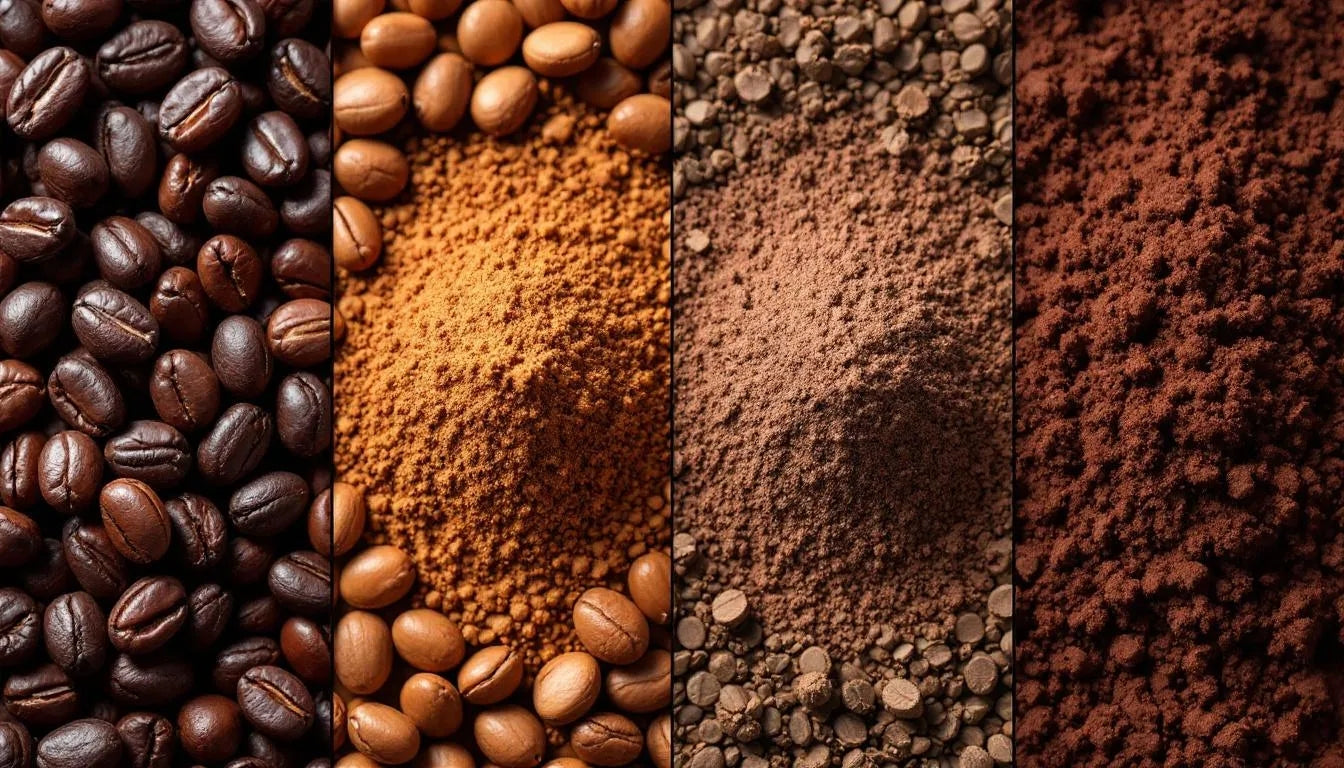
Is Cacao the Same as Cocoa Powder? Understanding the Key Differences
If you've ever stood in the baking aisle wondering whether to grab cacao or cocoa powder, you're not alone. No, cacao and cocoa powder are not the same, despite both coming from the same cacao bean. The crucial difference lies in processing methods that dramatically affect their nutritional content, flavor profile, and health benefits. Understanding these differences will help you make informed choices for your health, recipes, and taste preferences.
The Simple Answer: Processing Makes All the Difference
Cacao powder is made from raw, unroasted cacao beans that are cold-pressed to remove the fat (cacao butter), then ground into a fine powder. This minimal processing preserves the bean's natural enzymes, antioxidants, and complex flavor compounds.
Cocoa powder comes from cacao beans that have been roasted at high temperatures (often 250-300°F) before being processed into powder. This heat treatment reduces nutritional content but creates a milder, sweeter flavor that many people associate with traditional chocolate.

Processing Methods: From Bean to Powder
Raw Cacao Powder Production
The journey of cacao powder follows these steps:
- Harvesting: Fresh cacao pods are opened to extract beans
- Fermentation: Beans ferment naturally for 5-7 days
- Drying: Sun-dried or low-temperature dried
- Cold-pressing: Beans pressed at temperatures below 118°F (48°C)
- Grinding: Remaining solids ground into fine powder
This gentle process preserves heat-sensitive nutrients and maintains the complex flavor profile that makes raw cacao powder so nutritionally valuable.
Cocoa Powder Production
Traditional cocoa powder processing involves:
- Roasting: Beans heated to 250-300°F for 10-35 minutes
- Grinding: Roasted beans ground into chocolate liquor
- Pressing: Fat removed under high pressure and heat
- Pulverizing: Remaining cake ground into powder
- Optional alkalization: Dutch processing with alkaline solution
The high-heat roasting fundamentally changes the bean's chemical structure, reducing beneficial compounds while creating the familiar "cooked chocolate" flavor.
Nutritional Differences: Why Processing Matters
Antioxidant Content Comparison
Raw Cacao Powder: Contains up to 95,500 ORAC units per 100g Cocoa Powder: Contains approximately 55,000 ORAC units per 100g
Cacao powder benefits include retaining 40-60% more antioxidants than processed cocoa powder. These flavonoids and polyphenols support heart health, reduce inflammation, and provide cellular protection.
Mineral Content
| Mineral | Raw Cacao Powder | Cocoa Powder |
|---|---|---|
| Magnesium | 499mg per 100g | 425mg per 100g |
| Iron | 13.9mg per 100g | 11.9mg per 100g |
| Potassium | 1524mg per 100g | 1311mg per 100g |
| Calcium | 128mg per 100g | 116mg per 100g |
Raw cacao powder's superior mineral content makes it an excellent choice for those seeking maximum nutritional benefits from their chocolate consumption.

Enzyme Activity
Raw Cacao: Retains natural enzymes that aid digestion and nutrient absorption Cocoa Powder: Heat processing destroys most natural enzymes
These live enzymes in raw cacao contribute to better bioavailability of nutrients and support overall digestive health.
Flavor Profiles: Taste the Difference
Raw Cacao Powder Characteristics
Flavor: Complex, intense, and slightly bitter with fruity and nutty undertones Aroma: Rich, earthy, and "raw" chocolate scent Texture: Fine powder that can be slightly denser than cocoa Best for: Health-focused recipes, smoothies, raw desserts
Our organic cacao powder from Peru's Criollo variety offers exceptional flavor complexity with notes that reflect its terroir and careful processing.
Cocoa Powder Characteristics
Flavor: Milder, sweeter, and more "familiar" chocolate taste Aroma: Classic baked chocolate scent Texture: Fine, light powder that dissolves easily Best for: Traditional baking, hot chocolate, desserts
Which Tastes Better?
For health-conscious consumers: Raw cacao's complex flavor becomes addictive once your palate adjusts to its intensity For traditional baking: Cocoa powder provides the expected "chocolate" flavor in familiar recipes For versatility: Understanding both options allows you to choose based on specific recipe needs
Health Benefits: The Clear Winner
Why Raw Cacao Powder Excels
Superior Antioxidant Levels: Cacao powder's antioxidant content ranks among the highest of any food, supporting cardiovascular health and cellular protection.
Mood Enhancement: Natural compounds like phenylethylamine and anandamide promote emotional well-being and mental clarity.
Energy Support: Cacao powder's caffeine content combined with theobromine provides sustained energy without crashes.
Mineral Density: Higher concentrations of magnesium, iron, and potassium support multiple body systems.
Cocoa Powder Benefits
Familiar Taste: Easier transition for those new to "healthy" chocolate options Lower Cost: Generally less expensive than raw cacao powder Widespread Availability: Found in most grocery stores Baking Performance: Predictable results in traditional recipes
Culinary Applications: When to Use Which
Raw Cacao Powder Best Uses
Smoothies and Shakes: Adds nutrition without compromising healthy ingredients Raw Desserts: Perfect for no-bake energy balls, truffles, and bars Breakfast Bowls: Enhances oatmeal, yogurt, and chia puddings Hot Chocolate: Learn how to make hot chocolate with cacao powder for maximum health benefits
Healthy Cacao Smoothie Recipe:
- 1 banana
- 2 tablespoons organic cacao powder
- 1 cup almond milk
- 1 tablespoon almond butter
- 1 teaspoon maple syrup
- Ice cubes
Cocoa Powder Best Uses
Traditional Baking: Cakes, cookies, brownies, and muffins Classic Hot Chocolate: Familiar flavor for conventional recipes Chocolate Sauces: Smooth integration in cooked applications Dusting: Light texture perfect for garnishing desserts
Recipe Conversion Tips
Substituting Cacao for Cocoa: Use 25% less cacao powder and add extra sweetener to balance intensity Substituting Cocoa for Cacao: Use slightly more cocoa powder and expect milder chocolate flavor Liquid Adjustments: Raw cacao may absorb liquids differently in some recipes
Cost Comparison: Investment vs. Budget
Why Raw Cacao Costs More
Limited Processing: Specialized cold-pressing equipment Quality Sourcing: Often single-origin and organic Lower Yields: Gentle processing produces less powder per bean Market Demand: Growing health consciousness increases demand
Budget-Friendly Strategies
Start with Small Amounts: Try small quantities of premium cacao before committing to large purchases Mix and Match: Use cacao for health-focused recipes, cocoa for traditional baking Bulk Purchasing: Buy larger quantities when you find quality sources Focus on Value: Consider cost per serving of antioxidants and minerals
Storage and Shelf Life Differences
Raw Cacao Powder Storage
Temperature: Cool, dry environment (60-70°F ideal) Light: Store in dark containers away from UV exposure Air: Airtight containers prevent oxidation Shelf Life: 2-3 years when properly stored Quality Indicators: Rich color and fresh aroma
Cocoa Powder Storage
Less Sensitive: More stable due to processing Standard Pantry: Room temperature storage acceptable Longer Shelf Life: 3-4 years typical Quality Loss: Gradual flavor fading rather than spoilage
Proper storage of cacao powder ensures you maintain maximum nutritional benefits and flavor complexity throughout its shelf life.

Environmental and Ethical Considerations
Raw Cacao Advantages
Sustainable Processing: Lower energy requirements for production Fair Trade Focus: Premium cacao often emphasizes ethical sourcing Single Origin: Our commitment to regenerative farming supports environmental stewardship Minimal Transport: Less processing means fewer transportation steps
Making Ethical Choices
Look for Certifications: Organic, Fair Trade, and Rainforest Alliance Support Small Producers: Single-origin products often benefit farming communities Understand Supply Chains: Our transparent sourcing from Peru's Huallaga Valley ensures ethical practices Quality over Quantity: Choosing premium products supports sustainable agriculture
Shopping Guide: How to Choose
Quality Indicators for Raw Cacao Powder
Color: Rich, dark brown without grayish tint Texture: Fine powder without lumps or grittiness Aroma: Fresh, chocolatey smell without mustiness Sourcing: Single-origin with clear provenance Certification: Organic and fair-trade verified
Red Flags to Avoid
Artificial Additives: Pure cacao should have one ingredient Unclear Origins: Vague sourcing information Processed Claims: "Raw" products heated above 118°F Extremely Low Prices: Quality cacao requires investment
Questions to Ask Suppliers
- What temperature was used during processing?
- Where are the cacao beans sourced from?
- Do you test for heavy metals and contaminants?
- What certifications do you maintain?
- How do you ensure freshness during storage and shipping?
Health Considerations and Sensitivities
Who Should Choose Raw Cacao?
Health Enthusiasts: Maximum antioxidant and mineral benefits Sensitive Stomachs: Natural enzymes aid digestion Energy Seekers: Natural caffeine and theobromine provide sustained energy Mood Support: Natural compounds enhance emotional well-being
Who Might Prefer Cocoa Powder?
Sensitive Palates: Milder flavor easier for some people Traditional Bakers: Predictable results in conventional recipes Budget-Conscious: Lower cost for regular consumption Children: Gentler introduction to chocolate flavors
Potential Considerations
Stimulant Sensitivity: Both contain caffeine, but cacao has higher levels Oxalate Content: Both are high in oxalates; consider if prone to kidney stones Histamine Response: Some people react to fermented cacao products Medication Interactions: Consult healthcare providers about stimulant interactions
Frequently Asked Questions
Can I substitute cacao powder for cocoa powder in recipes?
Yes, but adjustments are needed. Raw cacao powder is more intense and slightly bitter, so use about 25% less and add extra sweetener. The reverse substitution works by using slightly more cocoa powder.
Which is better for weight loss - cacao or cocoa powder?
Cacao powder offers superior benefits for weight management due to higher antioxidant content, natural appetite-suppressing compounds, and metabolism-supporting minerals. However, both are low-calorie when used without added sugars.
Is the caffeine content different between cacao and cocoa powder?
Yes, raw cacao powder contains more caffeine (about 12mg per tablespoon) compared to cocoa powder (about 8mg per tablespoon). Understanding cacao's caffeine content helps you manage your daily stimulant intake.
Why does raw cacao powder taste more bitter?
The roasting process that creates cocoa powder breaks down tannins and develops Maillard reactions that create sweeter, more familiar flavors. Raw cacao retains its natural bitter compounds, which actually contain many of the beneficial antioxidants.
Are there any safety concerns with raw cacao powder?
High-quality, organic cacao powder from reputable sources is safe for most people. However, it does contain natural stimulants, so those sensitive to caffeine should start with small amounts and avoid evening consumption.
How do I know if I'm buying real raw cacao powder?
Look for single-ingredient products labeled as "raw" or "cold-pressed," with processing temperatures below 118°F. Our organic cacao powder meets these standards and provides documentation of our gentle processing methods.
Quick Comparison Guide (Featured Snippet Optimized)
Cacao and cocoa powder are not the same. Cacao powder is made from raw, cold-pressed beans retaining maximum nutrients (95,500 ORAC units). Cocoa powder uses roasted beans, reducing antioxidants by 40% but creating milder flavor. Cacao offers superior health benefits while cocoa works better for traditional baking. Both are naturally gluten-free and vegan.
Make the Right Choice for Your Needs
Understanding the difference between cacao and cocoa powder empowers you to make informed decisions based on your health goals, taste preferences, and intended uses. Our premium organic cacao powder represents the pinnacle of quality, offering maximum nutritional benefits while supporting sustainable farming practices in Peru.
Whether you choose raw cacao for its exceptional health benefits or use both depending on your specific needs, you're embracing the wonderful world of chocolate in its various forms. Explore our complete collection of ethically-sourced cacao products to discover the perfect options for your lifestyle and culinary adventures.
Learn more about maximizing cacao's potential through our comprehensive blog, where we share the latest research, traditional wisdom, and practical applications for incorporating this ancient superfood into modern life. From understanding processing methods to mastering preparation techniques, we're here to guide your journey into conscious chocolate consumption.

Claire Bennett
I'm Claire, a chocolate lover and artisan based in a small town where I run a tiny home kitchen dedicated to exploring everything chocolate. From single-origin dark bars to creamy ganache and handmade truffles, I find joy in working with all types of chocolate. I believe chocolate has a story, and I love bringing that story to life through humble, heartfelt creations.



Leave a comment
This site is protected by hCaptcha and the hCaptcha Privacy Policy and Terms of Service apply.